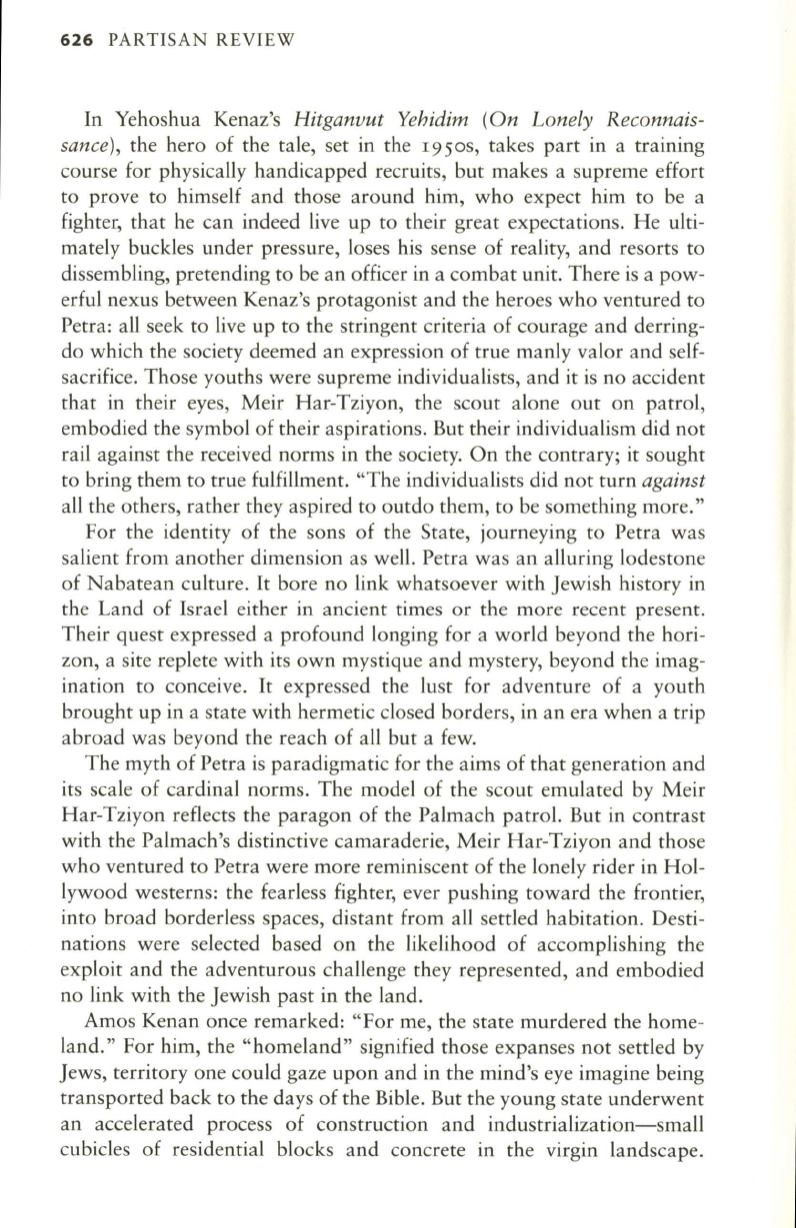
626
PARTISAN REVIEW
In Yehoshua Kenaz's
Hitganvut Yehidim (On Lonely Reconnais–
sance),
the hero of the tale, set in the
I950S,
takes part in a training
course for physically handicapped recruits, but makes a supreme effort
to prove to himself and those around him, who expect him
to
be a
fighter, that he can indeed live up to their great expectations. He ulti–
mately buckles under pressure, loses his sense of reality, and resorts to
dissembling, pretending to be an officer in a combat unit. There is a pow–
erful nexus between Kenaz's protagonist and the heroes who ventured to
Petra: all seek
to
live up to the stringent criteria of courage and derring–
do which the society deemed an expression of true manly valor and self–
sacrifice. Those youths were supreme individualists, and it is no accident
that in their eyes, Meir Har-Tziyon, the scout alone out on patrol,
embodied the symbol of their aspirations. But their individualism did not
rail against the received norms in the society. On the contrary; it sought
to bring them
to
true fulfillment. "The individualists did not turn
against
all the others, rather they aspired to outdo them, to be something more."
For the identity of the sons of the State, journeying to Petra was
salient from another dimension as well. Petra was an alluring lodestone
of Nabatean culture.
It
bore no link whatsoever with Jewish history in
the Land of Israel either in ancient times or the more recent present.
Their quest expressed a profound longing for a world beyond the hori–
zon, a site replete with its own mystique and mystery, beyond the imag–
ination
to
conceive.
It
expressed the lust for adventure of a youth
brought up in a state with hermetic closed borders, in an era when a trip
abroad was beyond the reach of all but a few.
The myth of Petra is paradigmatic for the aims of that generation and
its scale of cardinal norms. The model of the scout emulated by Meir
Har-Tziyon reflects the paragon of the Palmach patrol. But in contrast
with the Palmach's distinctive camaraderie, Meir Har-Tziyon and those
who ventured to Petra were more reminiscent of the lonely rider in Hol–
lywood westerns: the fearless fighter, ever pushing toward the frontier,
into broad borderless spaces, distant from all settled habitation. Desti–
nations were selected based on the likelihood of accomplishing the
exploit and the adventurous challenge they represented, and embodied
no link with the Jewish past in the land.
Amos Kenan once remarked: "For me, the state murdered the home–
land." For him, the "homeland" signified those expanses not settled by
Jews, territory one could gaze upon and in the mind's eye imagine being
transported back to the days of the Bible. But the young state underwent
an accelerated process of construction and industrialization-small
cubicles of residential blocks and concrete in the virgin landscape.


